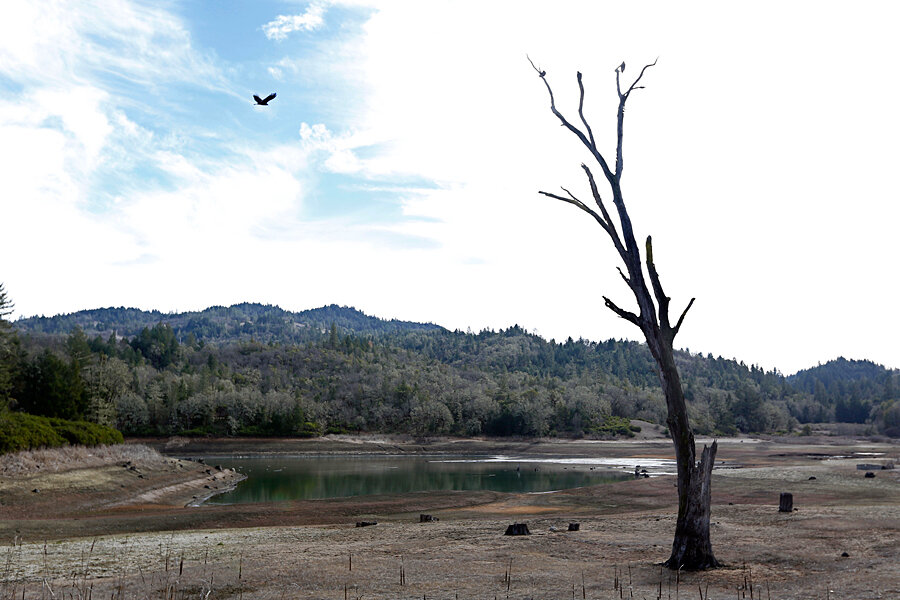In California drought, a message to consumers: Water is power
Loading...
| Los Angeles
The message to Californians is as unequivocal as it is counterintuitive to some: Take shorter showers, turn off the faucet while shaving, stop watering your lawn, and there might be enough electricity to power your air-conditioner in what is projected to be a long, hot summer.
In short, water equals electricity.
As California confronts the worst drought in its history, energy analysts say one positive outcome of the emergency is a much-needed conversation about the relationship in this state between water and electric power.
While the state gets power from a diverse array of sources, 15 percent comes from hydroelectric generation. And with the drought extending into its third year, water levels in the dams responsible for it are at very dangerous lows.
While Gov. Jerry Brown has declared a drought emergency, and local water distributors up and down the state have demanded stricter conservation measures, some residents of the Golden State are asking whether there will be a return to the blackouts and brownouts of the 2000-2001 energy crisis.
“It’s really imperative that Californians understand the inter-relationship between water and power, that if they can conserve now it’s only going to have a positive impact on power supplies come summer,” says Stephanie McCorkle, spokeswoman for the California Independent System Operator, which runs the California transmission grid.
Noting that some 17 districts are in danger of having no water within the next 60-100 days, she says, “any conservation now is going to have a double impact come summer.”
While a series of reasonably strong storms that will continue into this weekend has begun to bring significant rain to central California, officials say far more is required to begin to alleviate the severe drought conditions. Meteorologists, meanwhile, say it’s too soon to know whether the underlying weather pattern that so far has blocked the seasonal rains has broken down or is just taking a breather.
Last week, state water officials dropped projected deliveries to agricultural and municipal agencies south of the Sacramento-San Joaquin Delta to zero for the first time, and instituted emergency procedures to protect the delta from saltwater intrusion.
“Never mind the restrictions on watering your lawn. The drought is drying up California’s supply of hydroelectricity, prompting SMUD [Sacramento Municipal Utility District] and other utilities to scramble,” declared the Sacramento Bee, Feb. 3.
State utilities have been in full-court press mode in creating additional sources of electrical generation since the 2000-2001 energy crisis here, when intermittent blackouts made national and international headlines – and were one key reason behind the recall of former Gov. Gray Davis.
Over a dozen years later, the fruits of that focus have put the state in good stead, with a much more diverse power grid, with added solar and wind capabilities, but also transmission lines that can help power traverse the state to where it’s needed – an often insurmountable problem in the past.
Transmission connections to other states – especially Oregon and Washington – have also improved dramatically, giving state operators more options when summer demands are extremely high.
Ms. McCorkle says there has been an investment of about $10 billion in energy production since the crisis, resulting in 20,000 additional megawatts of power capability since then – with one megawatt providing the energy for about 750 homes for one year. It has become more diverse as well – from solar, wind, and natural gas capabilities.
“We can never take it for granted, but what I can tell you since 2001, there has been a sea change in attitudes at California utilities and the Public Utilities Commission, and we are in incomparably better shape now than then,” says Ralph Cavanagh, energy program co-director for the Natural Resources Defense Council.
He and others hope that the sea change in producers’ attitudes will be reflected in the thinking of consumers of both power and water.
One reason hydroelectric power is so valuable is that it can be stored and used at times of high demand, unlike regular electricity, which can’t be stored at all.
“Hydro is one of few ways you can store electricity,” says McCorkle. “It can be dispatched quickly and shut off at will – we can back it off if the wind comes up or if we have more solar than expected. So people need to understand that having that capability is crucial. That’s one reason we are holding back on water flows right now, to be ready for summer,” she says.
Hydropower is also far cheaper than the alternative of natural gas, and is appealing because it doesn’t produce carbon emissions.
“Yes the alternative [of natural gas] will have some cost increases, but my main concern is carbon,” says Mr. Cavanagh.







